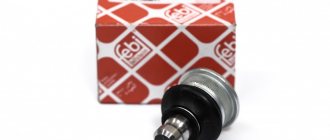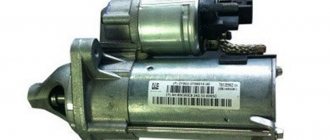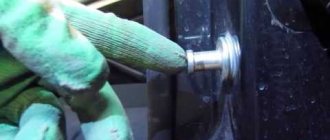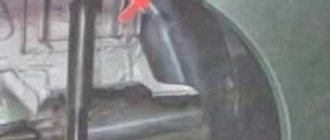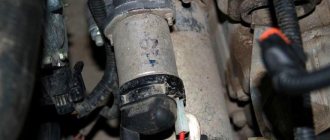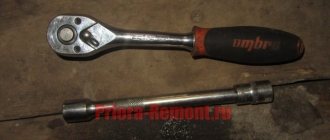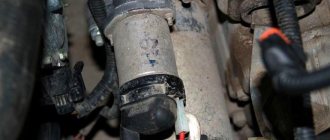The Lada Largus washer reservoir is one of the components of the glass cleaner system of a domestic station wagon, which plays an important role, but often goes unnoticed in everyday use.
The Lada Largus washer reservoir acts as a battery, which stores a supply of windshield washer fluid for the windshield and rear door glass.
On older cars, the washer reservoir was made in the form of a rubber bag. This significantly reduced the cost of production and simplified the design. Only in more modern cars did they begin to use a plastic tank for washer fluid.
Lada Largus washer reservoir where is it located
Note: Part numbers for the front washer can be found here and the rear washer can be found here Please note that the windshield washer pump (motor) differs depending on whether the rear washer is installed, i.e. may have one or two fittings.
Washer pump with two fittings: 1 – fitting for supplying liquid to the glass of the tailgate; 2 – electric motor; 3 – electrical connector; 4 – fluid supply fitting to the windshield
We carry out work when the pump fails and the washer reservoir is damaged (leaky). Disconnect the wire terminal from the negative terminal of the battery.
Remove the seal from the bulkhead of the front panel.
Using a screwdriver, pry off the piston pin and remove the piston fastening the right windshield trim
Remove the hose from the holder on the windshield trim.
Remove the right windshield trim.
Having released the clamp of the wire block, disconnect the block from the washer pump.
Using a 10mm socket, unscrew the bolt securing the washer fluid reservoir.
We remove the hose seal from the recess in the bulkhead of the bulkhead.
By turning the tank, we remove the hose from the recess of the bulkhead of the bulkhead (the arrow indicates the recess).
We remove the tank from the drainage box.
. and, prying the pump with a screwdriver, remove it from the tank.
Remove the pump seal from the reservoir.
There is a strainer at the bottom of the sealing sleeve. If the bushing is torn, cracked or has lost elasticity, replace it with a new one.
Remove the fluid supply hoses to the washer nozzles from the pump fittings and remove the pump.
Install the washer pump and reservoir in reverse order. We connect the hoses to the pump fittings: to the white fitting - the fluid supply hose to the nozzle on the tailgate door (with an L-shaped fitting, see position A in the previous photo); to the black fitting - a hose for supplying fluid to the injectors on the hood.
Lada Largus - where is the washer reservoir?
The Lada Largus washer reservoir is located under the hood of the car on the passenger side on a plastic frill. The photo shows where the washer reservoir is located:
There is one reservoir for the front and rear washers.
The article number of the Lada Largus washer reservoir is 289106288R.
Washer nozzle Lada Largus
To replace and search, use article number 77 00 846 456. This part looks like this:
Where to pour water in Vesta?
The washer reservoir on the Lada Vesta is located on the right side under the frill. To access it, you will first have to dismantle the wipers and the plastic element installed under the windshield.
Interesting materials:
What is Dissociative Identity Disorder? What is Dysthymia? What is a fraction of a number? What is a dirt road? What is dignity? What is bad? What is edelweiss? What is Excel on a computer? What is expressiveness in speech? What is an eccentric person?
Where is the washer reservoir in Largus
It is necessary to periodically check the fluid level in the windshield washer reservoir and the tailgate glass and, if necessary, add fluid. At an ambient temperature of +2 °C and below, only special windshield washer fluid or concentrate diluted with water in the required proportions should be poured into the tank. Water or highly diluted windshield washer fluid may freeze in the reservoir, pipes or washer nozzles. Pure water is permissible for use only in the warm season. The windshield washer reservoir is located in the engine compartment on the right side, under the windshield trim.
Open the filler cap of the tank. Visually check the fluid level through the neck. If it is needed…
...add fluid to the reservoir. Close the lid of the glass washer reservoir.
Note: Part numbers for the front washer can be found here and the rear washer can be found here Please note that the windshield washer pump (motor) differs depending on whether the rear washer is installed, i.e. may have one or two fittings.
Washer pump with two fittings: 1 – fitting for supplying liquid to the glass of the tailgate; 2 – electric motor; 3 – electrical connector; 4 – fluid supply fitting to the windshield
We carry out work when the pump fails and the washer reservoir is damaged (leaky). Disconnect the wire terminal from the negative terminal of the battery.
Remove the seal from the bulkhead of the front panel.
Using a screwdriver, pry off the piston pin and remove the piston fastening the right windshield trim
Remove the hose from the holder on the windshield trim.
Remove the right windshield trim.
Having released the clamp of the wire block, disconnect the block from the washer pump.
Using a 10mm socket, unscrew the bolt securing the washer fluid reservoir.
We remove the hose seal from the recess in the bulkhead of the bulkhead.
By turning the tank, we remove the hose from the recess of the bulkhead of the bulkhead (the arrow indicates the recess).
How to choose the right antifreeze liquid
Antifreeze is a liquid based on water and alcohol, and the higher the content of the latter in the solution, the lower temperature it becomes (at 50% content it can withstand temperatures down to -30C). In severe frosts, therefore, liquid concentrate should be poured into the washer reservoir, and at -5-10C you can dilute the anti-freeze with water.
Today there are many windshield washer fluids on the market from various foreign and domestic manufacturers, with different chemical compositions and conditions of use. How not to make a mistake with your choice, buy an anti-freeze product with the required crystallization limit (freezing temperature) and not stumble upon a counterfeit product?
Read the labels on windshield washer fluid containers! It should indicate:
- crystallization (freezing) temperature – from trusted manufacturers on the packaging it is indicated for the concentrate with a margin of several degrees;
- kinematic viscosity - fluid fluidity and thickening conditions (thickened antifreeze clogs the nozzles);
- surface tension coefficient - the ability of a liquid to wet surfaces and impregnate dirt (the higher the better);
- surfactant content (surfactants) – the less, the better.
A separate and very important characteristic is the type of alcohol used in the solution. Ethyl alcohol is considered the highest quality and most expensive, the most popular is inexpensive and effective isopropyl alcohol, the most dangerous to human health and prohibited in legal production is methyl (methanol).
Article number of the Lada Largus rear door washer tube
As I said above, the most common failure of the rear door washer is the breaking of the tube running between the body and the door. This is a completely natural failure associated with the design of the tube itself, which I would hardly dare to call successful.
You can order the handset using the following article number: 8200766091 It looks like this:
Window washer pump Lada Largus
Pump part number: 6001549443 It looks like this:
Fuse
The protective elements of the washer system are located on the left side of the dashboard, under the plastic cover, see photo:
Fuses numbered F01(20A) and F27(20A) are responsible for the operation of the windshield wipers and washers of the windshield window and tailgate, respectively. They need to be removed one by one and the condition assessed. Burnt out elements should be replaced with new ones.
Largus rear window washer reservoir
I remembered my former love (VAZ 2112). There were two tanks, both in the engine compartment. I decided to do something similar here too. You can, of course, put another tank in the engine compartment, on the right in the direction of travel, there is a little space there. A washer reservoir from a VAZ 2104 is suitable for this. But on many cars with a rear windshield wiper, the reservoir is placed at the back, for example a VAZ 2104, or even in the door (Chevrolet Niva). After much thought and fitting in the car shop window, I decided to buy a reservoir from Shniva, it is flatter, and install an additional reservoir for the rear window washer.
Rear window washer reservoir, fan nozzles and valves
Well, I also bought a pump motor, terminals with chips and wires. There were three installation options. The first and main thing, it seemed, was the door. But after removing the door trim, I realized that this was a bad idea. Firstly, there is not enough space in the door, and to accommodate the tank (which also has large walls that are not parallel), you will have to cut out a decent piece of the casing in the area of the recess. However, there was no desire to shred and disfigure the casing. And I have an electric pump lying very conveniently in my niche.
There were two options left, in the right or left trunk pockets. Where the nets are. In the right pocket, the tank sits a little lower due to the slanted bottom and is not so noticeable. But then there is no room for standard tools and the hose needs to be dragged far. Therefore, we put the tank in the left pocket. Moreover, both the hose and the ground connection point are conveniently and close located there. At the same time, I cut off the mounting brackets; they do not extend along the length. All that remains is to stretch the power wire (mine is green, like the one for the front washer). We run the wire parallel to the standard harness; I already have the power wire to the cigarette lighter socket in the trunk and the cable from the rear view camera laid there, so my hand is already full. I connected the hose with one side to the pump, the other to the green adapter, you can install a check valve in the gap.
Lada Largus washer reservoir rubs the body
Please note that the washer reservoir may rub the body at the point of contact. The car's paintwork is wiped, and rust forms on the exposed metal.
Therefore, it is recommended to dismantle the washer reservoir, treat the exposed metal and cover the contact points with sound-insulating material.
In order not to encounter breakdowns of the Lada Largus glass washer in the future, it is recommended to control the washer level in the tank, preventing it from being completely used up, pouring only clean liquid into the system, and also not using plain water in the cold season. Treat your car with care and it will reciprocate.
What you need to know when replacing a windshield washer
Maintaining the windshield washer system does not require much effort, but it is better to monitor and service it regularly to prevent blockages, traffic jams or ice from appearing in the winter. Important to remember:
- The system should be pumped periodically to remove air and water from it. This should be done before each new anti-freeze fill.
- There should always be a container with 3-4 liters of windshield washer fluid in the trunk to top it up if the reservoir is empty in the middle of the road.
- There is no need to fill the washer reservoir to the top. If the anti-freeze suddenly freezes, you should have room in the tank to add hot water, alcohol or anti-freeze concentrate to melt the ice.
- Antifreeze concentrate can be diluted if there is no serious frost or thaw outside, but the liquid and water should be mixed not in a tank, but in a separate container. This way you will protect the system from accidental incompatibility of components and will be able to control the concentration of the finished solution.
- If you accidentally poured low-quality anti-freeze into the tank, you should drain it completely. If you poured in a liquid with an inappropriate freezing point, you can simply add concentrate.
How to remove the washer reservoir on a Largus
Lada Largus, like any other car, has certain disadvantages. Some shortcomings can be ignored, while others are best eliminated as quickly as possible. An example of such a case could be the washer reservoir; its fastening and shape are not entirely successful, which allows it to peel off the paint of the engine shield.
To check the condition of the paintwork, we remove the Largus washer reservoir. To do this, snap off the clip, remove part of the wind lining (frill), disconnect the hoses and unscrew one screw securing the tank (Torx T30 wrench). This process is also shown in the video:
Under the washer reservoir you can see a damaged area where the paint is no longer there. To prevent this you can do different things:
- perform sound insulation of the engine shield;
- cover the washer reservoir with splen, vibroplast or other material that does not absorb moisture;
- Place rubber seals under the tank.
Also check the condition of the drainage hole and clean it if necessary.
Let us remind you that another drawback of the Lada Largus model is the short fifth gear. But the design of the transmission allows you to change the 5th gear gears without disassembling the entire gearbox or even removing it from the car. Have you experienced paintwork damage due to the washer fluid reservoir? How did you solve the problem?
Note: Part numbers for the front washer can be found here and the rear washer can be found here Please note that the windshield washer pump (motor) differs depending on whether the rear washer is installed, i.e. may have one or two fittings.
Washer pump with two fittings: 1 – fitting for supplying liquid to the glass of the tailgate; 2 – electric motor; 3 – electrical connector; 4 – fluid supply fitting to the windshield
We carry out work when the pump fails and the washer reservoir is damaged (leaky). Disconnect the wire terminal from the negative terminal of the battery.
Lada Largus. Removing the windshield washer and tailgate glass
We carry out work when the pump fails and the washer reservoir is damaged (leaky).
Disconnect the wire terminal from the negative terminal of the battery.
Remove the seal from the bulkhead of the front panel.
Using a screwdriver, pry up the piston pin and remove the piston fastening the right windshield trim (for more details, see “Removing the windshield wiper,” p. 224).
Using a 10mm socket, unscrew the bolt securing the washer fluid reservoir.
Remove the fluid supply hoses to the washer nozzles from the pump fittings.
Install the washer pump and reservoir in reverse order. We connect the hoses to the pump fittings: to the white fitting - the fluid supply hose to the nozzle on the tailgate (with an L-shaped fitting, see position A in the previous photo); to the black fitting - a hose for supplying fluid to the injectors on the hood.



